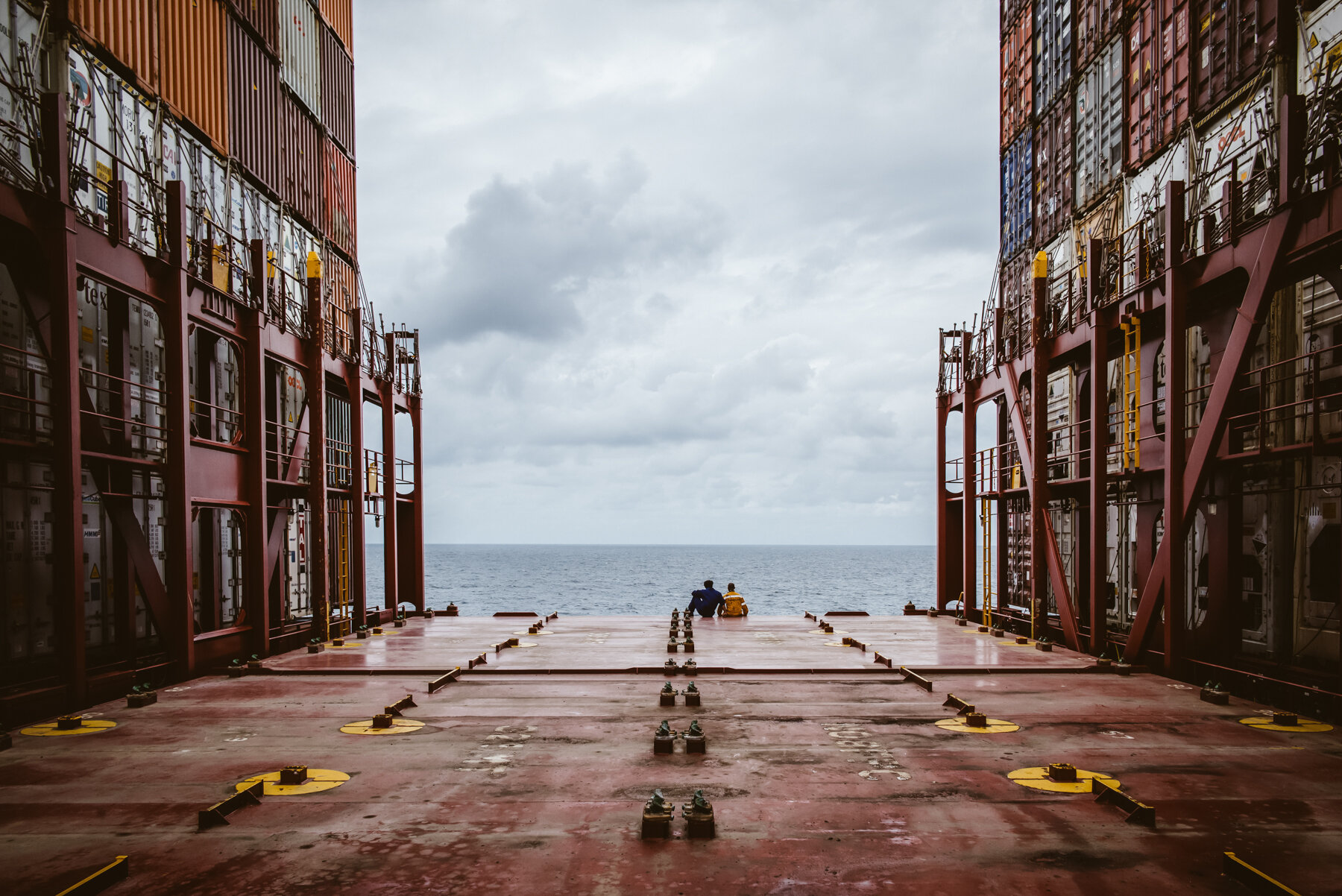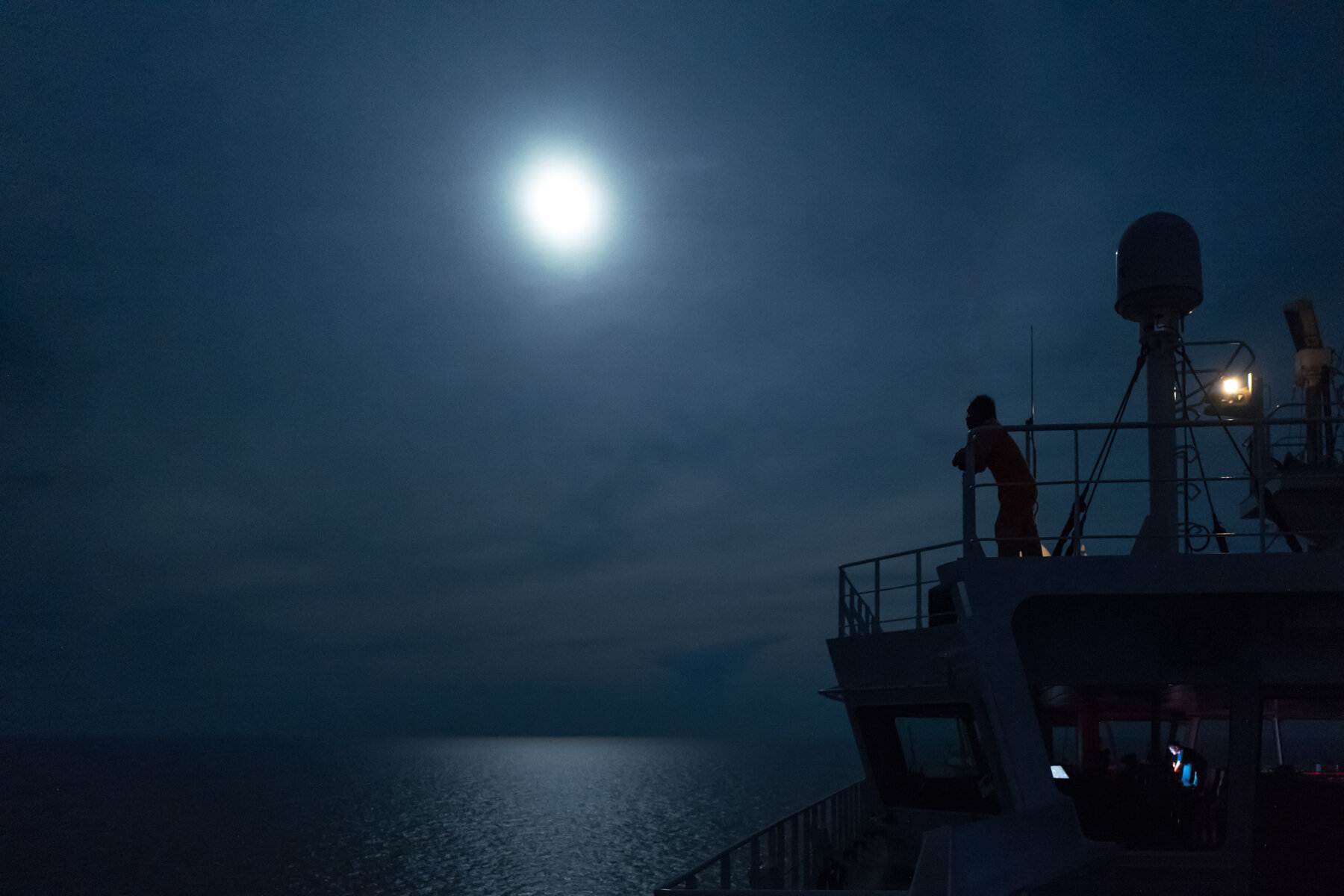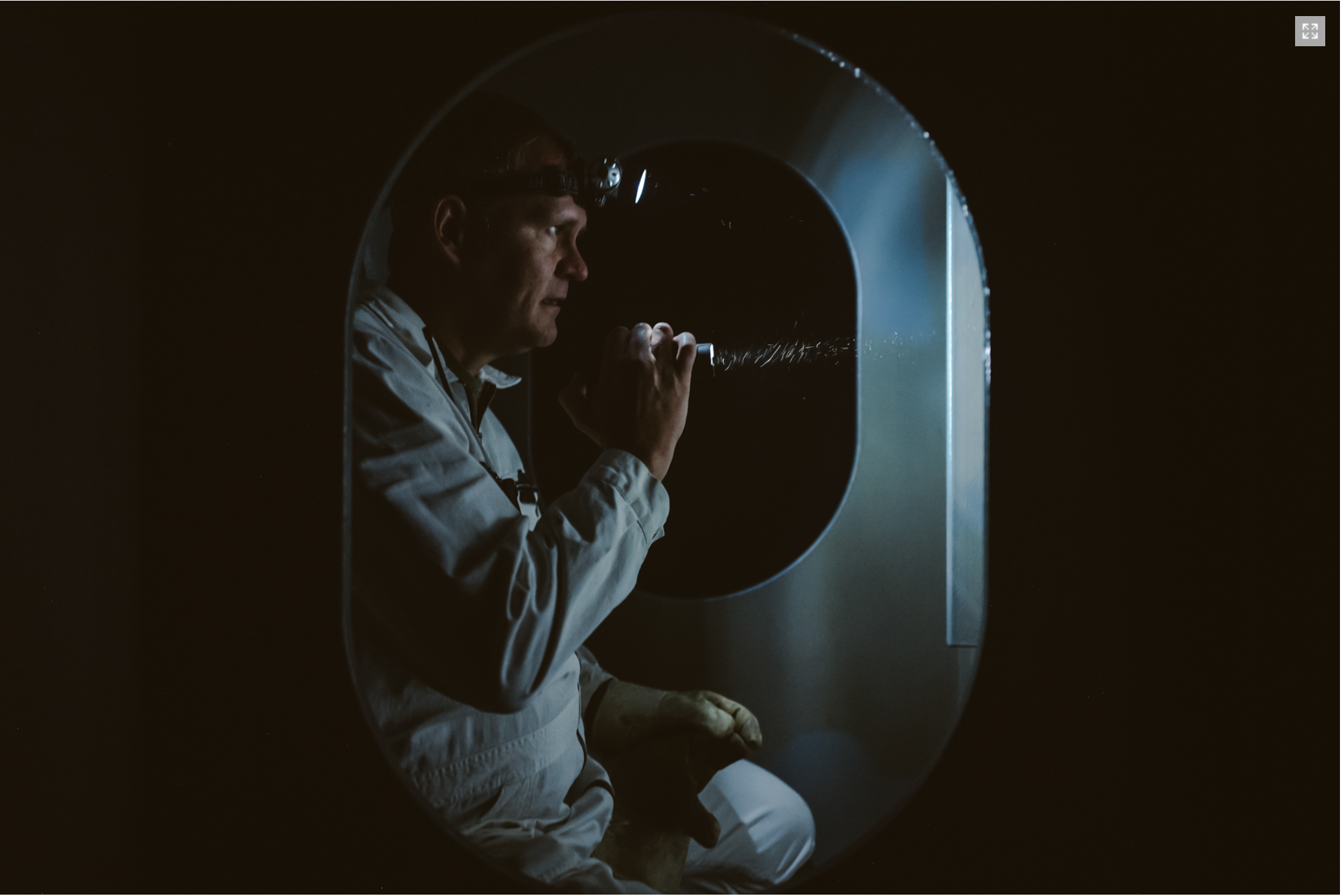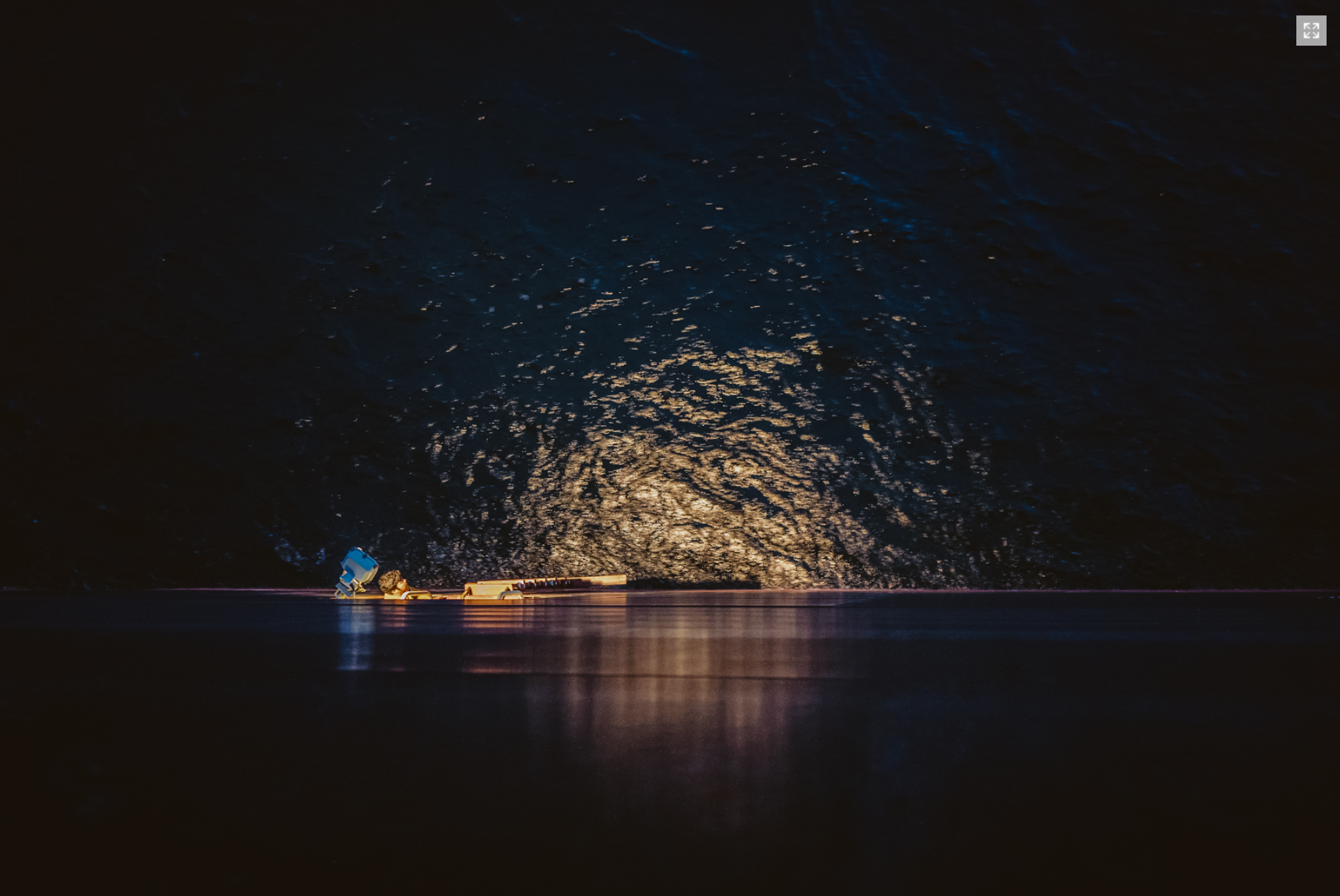SEAFARERS
I traveled on Hapag-Lloyd container ships for six weeks to document the work and the life that takes places on board. Coming from Hamburg, I’m often down by the Elbe River and watch the giant ships entering and leaving the port. It’s always been my dream to ride along on a container ship, to go ashore with the sailors at the next port and see what they see on their travels. In my imagination, I’d be sitting all night with the sailors in a bar by the port in the Caribbean, and we’d leave it around dusk to sail out of the port as the sun rises.
Reality was very different. The time spent in the port is becoming shorter and shorter. The ships are often in port less than a day before heading out again. There’s hardly any time to go on shore.
We all have so many products that were brought to us by ship. Electronics, food, clothing – a lot of things are transported in container ships. 90% of international trade is shipped by sea. It doesn’t take a lot of people to sail a container ship. At Hapag-Lloyd, a crew is made up of 22 men and women. The seafarers are on board for up to eight months and can only contact their friends and family via the internet while in port. With this project, I wanted to give a human face to the seafarers who go without so much on their travels so that we don’t have to go without anything and can buy products from around the world at the store around the corner from our homes.
This project was not commissioned. It was a very personal report. I wanted to tell this story. Which is why it was met with considerable skepticism from the ship management department at Hapag-Lloyd. Initially, no one was interested in giving a photographer a look at life on board. And why should they? It took about a year and a half of convincing before I finally got the green light. In the end, a major corporation decided to set aside its concerns and saw it for what it was: an opportunity to tell the stories of the people on board, away from the “big business” focused on freight rates, efficiency and growth. Without these people, the ships wouldn’t sail.
I flew to Singapore in September 2016. From there, I was going to be traveling with the “Leverkusen Express” (13,200 TEU) via Taiwan and South Korea to China. I put a lot of thought before the trip into which equipment I was going to use to take the photos for my report. I decided pretty quickly to take the Leica, since that is the smallest system on the market that features a full-frame sensor. I had already been on board a container ship once before in 2013. At the time, I had photographed everything using an Olympus OM-D. That worked really well, since I had all the important things with me in a little bag when I was moving around the ship. Size and weight aren’t an issue on the ship. Theoretically I could take along equipment of any size, but I wanted to have the important pieces with me at all times so that I wouldn’t have to run back to my cabin if something interesting was happening somewhere. It’s also very narrow in a lot of places, so a big DSLR wasn’t an option for that reason. But I still wanted to have the big sensor combined with fixed focal lengths that handle different types of lighting well. In addition to that, I really like the look of the pictures that come out of a Leica M and it seemed really well suited for the report.
At the time, I had an M240 and a Q. My biggest problem was having a backup. What would happen if my camera broke while I was at sea? If the M were to break, I’d only have the Q. As far as I know, Leica doesn’t currently offer high-seas repair services. So I borrowed a second M240 body. The Leica headquarters in Wetzlar, Germany, were nice enough to loan me a replacement body for the project. And that was really good. When I arrived in Singapore, I realized that my M wasn’t focusing properly anymore. The pictures weren’t quite coming out sharp. The alignment of the rangefinder was obviously off. It probably happened during transport in my carry-on luggage. I might have knocked into something with the camera. Luckily, I had the backup, which I used for the entire trip.
There’s something I like to call the “Leica factor.” Once we were on board, it took a few days for the crew to warm up to me. At first, I was an outsider and the crew treated me skeptically. Slowly but surely, though, the seafarers eased up. I told them exactly what I was doing and what the idea behind the project was – that I wanted to tell their stories. At some point, they became pretty proud to be part of this report. The “Leica factor” always kicks in when you go up to other people holding an M. For people who don’t keep up with photography, the camera kind of looks different, maybe a little old-fashioned. Some even think it’s an analog camera. They’re curious about what kind of a camera it is and why someone who claims to be a professional photographer is working with a little thing like that. That was often a conversation starter on board. The pilots in Korea and Hong Kong were particularly interested in the project and the photo tech.
I try not to ascribe too much importance to the gear, but the red dot does have a certain allure. My second trip was from Valparaiso in Chile, through the Panama Canal, to Cartagena in Colombia. The ship was the brand new “Valparaiso Express,” which was also christened in Valparaiso. I was supposed to take a few photos for Hapag-Lloyd to document the christening ceremony. For the official press photo, I was standing there with my little M between about ten other photographers with huge DSLRs. There wasn’t a lot of time, so I called called out “Everyone look at the photographer with the little camera!” and looked out over the camera as I laughed. That got their attention immediately and I got my picture – with everybody actually looking at the camera. That’s what I call the “Leica factor.”
” T H E R E ’ S S O M E T H I N G
I L I K E T O C A L L
T H E “ L E I C A F A C T O R .”
. . .T H E C A M E R A K I N D O F
L O O K S D I F F E R E N T ,
M AY B E A L I T T L E
O L D – F A S H I O N E D .
S O M E E V E N T H I N K I T ’ S
A N A N A L O G C A M E R A .”
It was clear to me from the beginning that I wouldn’t be able to do very much with a tripod on a moving ship. I’m not really the type for tripods anyway – I find they usually get in my way. That’s why I opted for fast lenses that can handle low light. In addition to the Q with the 28 mm Summilux, I had a 21, 35 and 50 mm Summilux with f/1.4 for the M, as well as the 75 mm f/2.0 Summicron. I didn’t have the 21 yet on the first trip, just a borrowed 24mm Summilux. That’s what I used to take the photo of the ship below the Milky Way. To be honest, I don’t know anything about star photography. It was clear to me, though, that the moving ship could be a problem. Instead of a tripod, I had a clip with me that I could use to fasten the camera to the railing. The sea was really calm that night, and we were going very slow because there were a lot of fishing boats around us that were trying to attract squid with their bright lights. That was my chance to try and get a photo of the night sky, which can really be breathtaking out at sea. There’s absolutely no light pollution from the cities. I had to experiment a little with the exposure time, ISO and aperture settings. In the end, it worked out at 8 seconds at f/4.0 and ISO 800, despite the moving ship. I only found out later from someone else that it was the Milky Way that could be seen in my photo. I don’t know anything about stars, but the night sky over the ocean is absolutely astonishing.
” I D O N ’ T K N OW
A N Y T H I N G A B O U T S T A R S ,
B U T T H E N I G H T S K Y
O V E R T H E O C E A N I S
A B S O L U T E LY A S T O N I S H I N G .”
I also thought a lot about ISO before the trip. It gets really dark on board, especially on the bridge at night. Then there’s only a bit of dim red light so that the officers on duty can see out into the dark night. I didn’t want to put the M240 up to anything more than ISO 1600. But the Q usually worked out really well for me, since it produces good shots even at up to ISO 6400. On my last trip with the Callao Express from Hamburg to Le Havre, I also had the M10 to work with, which was brand new at the time. I have to say, that really changed a lot of things. All my concerns about high ISO settings were history after that. In the end, though, there weren’t all that many photos taken at high ISOs. There are only five photos in the book that were taken at higher than ISO 1600. You always worry so much about all the possible situations you need to be prepared for. In reality, those extreme situations don’t occur very often.
As I mentioned, I had a 24 mm Summilux with me for the first trip, which I had to return afterwards. I thought I would be well-equipped with 24 mm, but a ship is big and you usually can’t back up a few more steps. On the second trip, I had the 21 mm, which gave me a few precious millimeters more. But even with the 21 mm, there’s no way to get anything near the entire cargo space in one photo. In order to give viewers an idea of how big one of these ships is, I needed photos that show size comparisons. Like a sailor alone in the cargo hold. I used a 15 mm Voigtländer on my last trip for that.
You need sturdy equipment out at sea. Wind, rain, salt water and high humidity can’t be a problem for it. Container ships are also really dirty. If you’re moving around on deck or in the engine room, your hands get dirty immediately. The camera needs to be able to handle that, because I didn’t want to have to constantly be worrying about dirt getting on the equipment. Then there was the same issue again every morning: As soon as I left the air-conditioned cabin, the lens would fog up. It would take almost 15 minutes before I could finally take the first picture. My camera was constantly getting knocked around as I climbed around in the cargo holds, on the foremast or in the funnel. My lenses all have quite a few little quirks at this point and probably don’t have much resale value, but they haven’t failed me yet and still work without any problems. Besides, I think cameras and lenses should show that they’ve been used. You should be able to tell the difference between a photographer’s camera and a collector’s camera. 😉 I’ve never had to remove so many sensor spots from my photos because I was often changing lenses outside on deck in all sorts of weather. Of course you think about whether the equipment could get damaged – but then you do it anyway because you want to take the photo and that’s all that really matters.
The only photos I didn’t take with a Leica are the ones using the drone. I thought about putting a Leica Q on a drone, but opted against it because the Q doesn’t transmit live images via HDMI, so I wouldn’t have been able to see what was happening from the ground.
In order to get Hapag-Lloyd’s approval for my project idea, I really had to talk things up and I promised them stunning aerial photos of their ships. In the past, that was usually done from a helicopter. But container ships are a day or two late sometimes and it can get really expensive if you have to pay to have a chopper on stand-by.
The chance came in the South China Sea, about 280 nautical miles off the coast – I wanted to do the first drone flight. The problem was that the ship was moving. That would make the homecoming feature a dangerous option. If the signal were to get disrupted and the drone were to fly to its launch spot, it would land in the water. We were going about 17 knots and had about 15 knots of headwind. The captain held the drone high in the air to launch it so that there wouldn’t be any obstacles. And right away, the tiny little thing disappeared towards the funnel. My heart was racing and I was really tense. It was incredibly bright out and I could hardly look into the sky. I had to rely entirely on the screen and was trying to get the drone under control. I had underestimated the speed of the ship and had to switch to sport mode. The drone flies a lot faster then, but a lot of the helper systems are deactivated. Bit by bit, the drone made its way back to where I was standing on the bridge wing (the outer area on the starboard and port sides of the bridge). It was impossible to land, so the captain had to catch the drone from the air. The first flight had been completed, and I was more than a little proud. Too bad I’d forgotten, in all the excitement, to turn the camera on. Shoot. Half the crew was huddled around me and wanted to see pictures. Okay, beer was on me that evening. For the next flights, the captain was kind enough to slow the ship down a little and I was able to get some great aerial shots that really went over well with Hapag-Lloyd.
” O F C O U R S E Y O U
T H I N K A B O U T W H E T H E R
T H E E Q U I P M E N T C O U L D
G E T D A M A G E D –
B U T T H E N Y O U D O I T
A N Y W A Y B E C A U S E Y O U WA N T
T O T A K E T H E P H O T O
A N D T H A T ’ S A L L T H A T
R E A L LY M A T T E R S .”
On the trip from Chile, we stopped in Callao in Peru before continuing towards the Panama Canal. It had always been a dream of mine to sail through the Panama Canal and now that dream was going to come true. The “Valparaiso Express” was the largest ship ever to pass through the canal at the time. The new locks were opened in 2016, allowing ships with up to 14,000 containers to pass through. The “Valparaiso Express” has a capacity of 10,500 containers, is 333 m long and 48 m wide. That doesn’t leave a lot of space in the lock. Each lock is made up of three chambers. In all, a difference in altitude of about 28 m between the Atlantic and the Pacific has to be overcome. The process takes almost an hour for each lock chamber. Definitely precision work. Once you make it through the locks, you’re rewarded with an incredible trip through the jungles of Panama. You can even see crocodiles on the river banks sometimes. I was not at all prepared for that, though, with the focal lengths I had with me.
We crossed the Equator before we reached the Panama Canal. It was Sunday and if the ship isn’t in port, most of the crew has the day off. This Sunday, there was a barbecue and a baptism on the agenda. Hang on – a baptism? This is a ritual among sailors in which all sailors who are crossing the equator for the first time are baptized. The chief mate took on the role of Neptune and the ship mechanic, decked out in fake breasts made of coconut shells, played his wife. After the baptismal motto, I had to kiss the feet of Neptune’s wife, which were painted with a disgusting and incredibly spicy mixture, before I was thrown into the pool. Of course this ceremony wasn’t unpleasant or anything – a traditional bit of fun that I was glad to participate in. After the ceremony, we roasted a suckling pig on the outer deck and sat together well into the night. This sort of thing really helps people bond, and afterwards I felt like I had been accepted into the crew. That made it easier to stick my nose in every area of the ship. It was very important to me for this report that the crew didn’t act differently around me and that the photos were as honest as possible.
In between, of course, I had loads of time to review and edit the photos. You can’t take pictures all day long, after all. I had my Macbook and three external hard drives with me so the pictures could be backed up to multiple places and sorted right away. Most of the work was finished by the time I returned to shore. Sometimes I would wake up in the mornings and think: “What’s left for me to take pictures of today?” I would get the feeling sometimes that I had already taken pictures of everything. Then I had to pull myself together and think of the results. What story did I want to tell? Which questions did I want to answer? I had taken a lot of visually stunning photos. How many sunrises and sunsets do you need in one book, though? Not really more than one or two. But people who aren’t familiar with shipping have very simple questions. How are containers fixed in place? Who does the laundry? Where do the seafarers live? What do they do in their free time? My goal was to make a book that would draw readers in, offer them something new and answer a lot of questions. That’s why there are a lot of detailed views in the book, which aren’t exactly challenging from a photography point of view, but are important for the story. As I was going through and selecting the photos to use, I had to leave out a lot of good photos that were really nice, but they didn’t tell the story of the seafarers.
A forty-foot container can hold about 12,000 shoe boxes or 650 barrels of beer. The ships sometimes transport goods worth a billion dollars. There are about 1.5 million seafarers around the world. Of them, about 2% are women. For me, seafarers are the unseen heroes of global trade who bring us the things we take for granted. “Seafarers” puts a human face on these people and tells the story of their everyday life and work.











